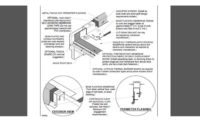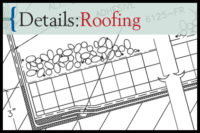

The attachment of the wood nailer to a masonry wall should comply with Factory Mutual Data Sheet 1-49, which specifies that bolts be installed in the top edge of the wall to anchor the wood nailer. If the installation of a scupper or ventilation is required, the wood nailer can be slotted.
Wood nailers are secured parallel to the perimeter edge and the roof surface. They are also installed as a baseboard for installing the counter flashing. On structural metal decks, the wood nailer serves as a shield against any wind that may penetrate into the flutes under the insulation, causing uplift.
The installation of the tapered cant strip is necessary to raise the roof elevation at the flashing location. It is essential to elevate the flashing above the roof surface. The tapered cant strip must be secured to the wood nailer and should be positioned above the roof surface. If the tapered cant strip were positioned below the roof surface, the flashing would be vulnerable at the joints due to the possible ponding of water.
Metal Flashing
The most important aspect of the perimeter edge flashing is the use of metal flashing. At perimeter edge locations, the metal flashing is the distinctive attribute that determines the success or failure of the flashing because it shields the base flashing at the joints. A gravel stop is a proficient type of metal flashing used at the perimeter edge, performing these basic functions:
- It serves as a barrier that prevents loose aggregate from rolling off the roof.
- It is used as an edge termination for the membrane.
- It serves as a rain shield.
- It serves as top surface for the anchorage of the fascia strip.
The metal used for the gravel stop in these areas must be rigid, watertight at all end laps and connections, and flexible enough to withstand thermal and differential movement. If the roof designer intends to restrain the gravel stop from expansion and contraction, a thin-gauged metal should be fastened closely at approximately every 3 inches on center. In these cases, the recommendation is to use a 16-ounce copper, 24-gauge galvanized metal or 0.040-inch aluminum.
When the intention is to accommodate linear expansion and contraction of the gravel stop, a thicker 10-inch extruder section is required, and it should be fastened sparingly at approximately every 12 inches on center. In these applications, the fasteners should be staggered. The distinctive attribute in this type of situation is that the ends of the metal are left free to expand and contract. For this type of detail, it is recommended that the applied metals be fabricated from 22-gauge metal, 0.050-inch aluminum or 24-gauge stainless steel.
The gravel stop should always extend over the base flashing when it is installed at the perimeter edge to act as a shield over the flashing joints. The perimeter edge flashings that are not sloped or adequately shielded with proper metal tend to create the most problems.
It is also essential that a layer of plastic cement (for BUR or Modified Roofs) is applied over the membrane to isolate the gravel stop from the membrane. Sheet metal should never be directly applied over the roof membrane. The plastic cement will not only serve as an added waterproofing sealant, it will guard against the splits that often occur when the gravel stops are stripped in with the membrane. This detail is of extreme importance in the colder climates, such as in the North and Midwest, because this type of split is more prevalent in colder temperatures.

